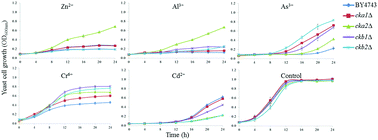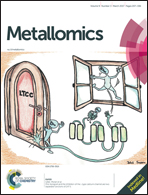Unravelling the role of protein kinase CK2 in metal toxicity using gene deletion mutants†
Abstract
Metal ions, biologically essential or toxic, are present in the surrounding environment of living organisms. Understanding their uptake, homeostasis or detoxification is critical in cell biology and human health. In this study, we investigated the role of protein kinase CK2 in metal toxicity using gene deletion strains of Saccharomyces cerevisiae against a panel of six metal ions. The deletion of CKA2, the yeast orthologue of mammalian CK2α′, leads to a pronounced resistant phenotype against Zn2+ and Al3+, whilst the deletion of CKB1 or CKB2 results in tolerance to Cr6+ and As3+. The individual deletion mutants of CK2 subunits (CKA1, CKA2, CKB1 and CKB2) did not have any benefit against Co2+ and Cd2+. The metal ion content in the treated cells was then measured by inductively coupled plasma mass spectrometry. Two contrasting findings were obtained for the CKA2 deletion mutant (cka2Δ) against Al3+ or Zn2+. Upon exposure to Al3+, cka2Δ had markedly lower Al3+ content than the wild type and other CK2 mutants, congruous to the resistant phenotype of cka2Δ against Al3+, indicating that CKA2 is responsible for Al3+ uptake. Upon zinc exposure the same mutant showed similar Zn2+ content to the wild type and cka1Δ. Strikingly, the selective inhibitor of CK2 TBB (4,5,6,7-tetrabromo-1H-benzotriazole) abolished the resistant phenotype of cka2Δ against Zn2+. Hence, the CK2 subunit CKA1 plays a key role in Zn2+ sequestration of the cell. Given that both zinc and CK2 are implicated in cancer development, the findings herein are of significance to cancer research and anticancer drug development.



 Please wait while we load your content...
Please wait while we load your content...